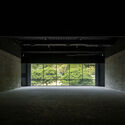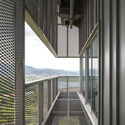Technology and Art Pavilion in TNUA / EHS ArchiLab + Hsuyuan Kuo Architects & Associates
Technology and Art Pavilion in TNUA / EHS ArchiLab + Hsuyuan Kuo Architects & Associates




 + 44
+ 44

Text description provided by the architects. Flotation is the imagery that encapsulates our vision for this architecture at the Taipei National University of the Arts (TNUA). An experimental base devoted to new media and technology art, the architecture is composed of several "boxes" of different scales that form the main structural facilities. In addition to performances, exhibitions, and lectures, the Technology and Art Pavilion accommodates an operations center, offices, lecture halls, laboratories, and workshops.



The design for the Technology and Art Pavilion stems from two parallel concepts: one is to echo the architectural tradition and forms found in NTUE, and the other is to connect with other spaces on the campus to invent a new field for art experimentations.



Currently, most of the architectures are symmetrical structures with inclined roofs and solid buttresses that affix to the slopes. Spatially these buildings often have atriums or courtyards. As an experimental base for new media art, however, the new Technology and Art Pavilion is crafted to embody the spirit of "contemporary" and "futuristic." As such its design departs from the traditional styles by deploying "black boxes" and "gray boxes" that hover in the mid-air and form the main body of the architecture. The "black boxes" and "gray boxes" are spatially defined to achieve both functionalism and structuralism. The outer space, or “skin” of the "black boxes" is consisted of ramps satisfying the service function while acting as channels for natural ventilation. In the meantime, the "gray boxes" are spaces of undefined functions, with their “skin” constituting an expansive net to allow transparency and light diffusion.




The building is situated at the end of the main road on the campus, originally a square leading to the Sports and Swimming Center and used for bus turnaround and car parking. The site may serve miscellaneous functions, but it certainly enjoys the most beautiful scenery on the campus for overlooking the Guandu Plain that stretches for hundreds of miles into the horizon. For this very reason, we deployed four large structures to elevate the enormous boxes and create a "rain cover" underneath. This space not only continues serving its original functions of parking and turnaround, as well as the entrance to the Sports and Swimming Center but also readily transforms into a site for art exhibitions, student activities, and public participatory events. Connecting upward from this space is a wandering path, sometimes adjoining, sometimes probing into the periphery of the black boxes, as you take in the breathtaking view of the vast Guandu Plain.









Gloss